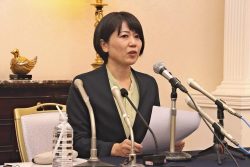
The Foreign Ministry head office is seen in Chiyoda Ward, Tokyo, on Nov. 1, 2020.
11:47 JST, December 25, 2020
The government has decided in principle to stop providing official development assistance (ODA) for the construction of new coal-fired power plants overseas.
The move is aimed at contributing to decarbonization within the international community by reallocating ODA from coal-fired power plants, which emit large amounts of carbon dioxide (CO2), to support for environmentally friendly renewable energy sources.
The re-examining of ODA follows a decision by the government in July that it would halt public funding for exports of coal-fired power plants with low environmental performance.
The government will no longer accept requests from other countries for assistance in the form of ODA, including yen loans, for coal-fired power projects.
ODA for coal-fired power plants will be provided in extremely limited cases, such as ones in which the latest technology is used to reduce CO2 emissions, according to a senior Foreign Ministry official. But because introducing such technology presents a high hurdle in terms of costs for emerging and developing nations, the provision of ODA for new coal-fired power plants in essence will be ended.
Prime Minister Yoshihide Suga has set a goal of zero greenhouse gas emissions by 2050, and expressed his determination to achieve this at United Nations-related conferences. Suga aims to demonstrate to the world his commitment to the environment by focusing ODA on decarbonization initiatives.
Coal-fired power continues to be implemented mainly in developing countries as an cheap energy source. Japan allocated about 5% of ¥1.3705 trillion in yen loans in fiscal year 2018 to support the introduction of this type of energy source. Most of the support went to Asian nations such as Vietnam and Bangladesh.
The government will provide support to developing and emerging countries for projects that focus on introducing technologies for renewable energy, such as wind and geothermal power, as well as efforts to reduce greenhouse gas emissions.
In its strategy for development of overseas infrastructure systems, which was revised in December, the government set a target of increasing the amount of orders for infrastructure exports from ¥25 trillion in 2018 to ¥34 trillion in 2025. It aims to use of ODA to prime the pump for expanding exports of decarbonization technologies to Asian and African nations.
"Politics" POPULAR ARTICLE
-

Japan to Support Central Asian Logistics Route That Bypasses Russia, Plan to Be Part of Upcoming Summit in Tokyo
-

Japan to Tighten Screening of Foreigners’ Residential Status by Providing Information of Nonpayment of Taxes
-

Takaichi Cabinet Approval Holds at 72% as Voters Back Aggressive Fiscal Stimulus, Child Benefits
-

Chinese, Russian Bombers Flew Unusual Path by Heading Toward Tokyo; Move Likely Meant to Intimidate Japan
-

Takaichi Meets Many World Leaders at G20 Debut in Johannesburg; Speaks with Heads of Countries Including Italy, U.K., Germany, India
JN ACCESS RANKING
-

Keidanren Chairman Yoshinobu Tsutsui Visits Kashiwazaki-Kariwa Nuclear Power Plant; Inspects New Emergency Safety System
-

Imports of Rare Earths from China Facing Delays, May Be Caused by Deterioration of Japan-China Relations
-

Japan Exports Rise in October as Slump in U.S. Sales Eases
-

Govt Aims to Expand NISA Program Lineup, Abolish Age Restriction
-

Blanket Eel Trade Restrictions Rejected
























